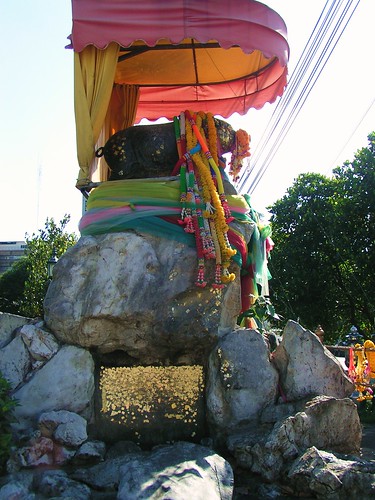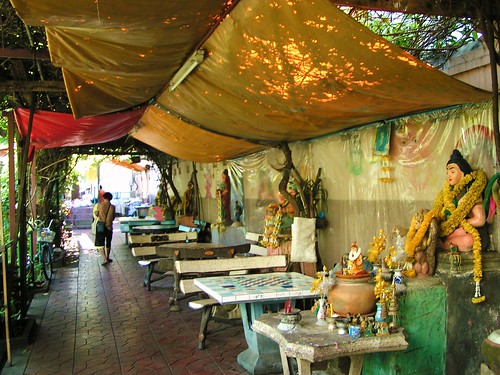You can, coming from the river with a map, join the canal at any point. It starts at Pak Klong Talat, the 24-hour flower, fruit & veg market, garlic and chilli sellers and pick-ups full of cabbages along its banks. It's easy enough to start there, getting the express boat to Saphan Phut, then walking the length of the Khlong to the point where it cuts off, at the big junction near Sanam Luang. Another good starting point is Tha Tien. The canal is a bit of a walk inland from here, but you'll see old shophouses by the river - not nearly as old as the canal but another picturesque remainder of Bangkok's development - and Wat Pho and Saranrom Royal Park are on the way, both of which are worth seeing and compact enough to be explored well in a short amount of time.
Follow the streets still further in from the park and you'll find the canal. Turning left to journey north yields the most interesting results, but if you want to see all the bridges, turn right and walk a little way down to Ubonrat Bridge, built as a memorial to Princess Ubonrat Nareenart in 1912, and Mon Bridge, built of teak in the nineteenth century and rebuilt in 1920, named for the Mon traders from Burma who moored their houseboats there.
 Double back and continue north past Saranrom Park to Pii Kun bridge, also called Saphan Muu. Both the bridge and the nearby Pig Memorial were built in 1913 for Queen Phatcharinthra's 50th birthday, to commemmorate her own birth as well as that of the three royal donors born in the same year as her - the year of the pig. The bridge is adorned with four pillars to represent birthday candles for the queen's four zodiac-cycles. The impressive building across the street from this is the Ministry of the Interior (1910).
Double back and continue north past Saranrom Park to Pii Kun bridge, also called Saphan Muu. Both the bridge and the nearby Pig Memorial were built in 1913 for Queen Phatcharinthra's 50th birthday, to commemmorate her own birth as well as that of the three royal donors born in the same year as her - the year of the pig. The bridge is adorned with four pillars to represent birthday candles for the queen's four zodiac-cycles. The impressive building across the street from this is the Ministry of the Interior (1910).Next is Chang Rong Si bridge, the 'rice mill elephant bridge', originally made of a tree thick and strong enough for elephants to cross over in the days when there was a royal rice mill here. It was rebuilt and reinforced by Prince Damrong Rajanubharb, the first Minister of Interior, in 1910, to commemmorate his birthday.
Onwards, past the Ministry of Defence (1880s) to Hok Bridge, reconstructed in 1982, which has a lifting mechanism for its middle section. Next up is Charoensri 34 (1913), built by Rama VI, who, after his coronation, built public bridges over canals (this was before river-bridges) to commemorate his birthdays. Near these bridges is Wat Buranasiri, built in the third reign by Chao Phraya Sutham Montri, in a mix of Thai and Chinese architectural styles.
Alongside the canal on the other side of Atsadang road there's an army surplus market and a row of guitar shops, selling standard acoustics, semi-acoustics, electrics, ukuleles, drums decorated in the style of temple murals, electric versions of Thai folk instruments with finial-heads, and other guitar-like creatures. (This is the best place I've found in Bangkok for ukuleles, by the bye).
Klong Lod ends at Pan Pibhop Leela Bridge (1906), by the big upcoming junction, but you can turn right and walk along Khlong Lod Wat Buranasri. Look out for the old water faucet on the corner, built in 1872 in the form of the Earth Goddess giving water to the people. Then go down along the canal, which was dug by Rama 1 in 1783 to connect the city moat to Rap Peung, cutting a strategic line across the city that would serve for transportation and communications. The name of this canal is somewhat fluid, never officially named and so taking the names of places it passes. It's narrower and more tree-covered than Klong Lod, and after passing some shops is lined by small village-like houses and shady walkways.
A pleasant time can be had wandering here. When I went, I encountered sleepy cats, friendly old inhabitants, trees wedged with statues and old toys to keep their guardian spirits happy, and an orange-juice vendor squeezing her cart between the waterside and old statue-dotted wall. An old woman saw my camera and insisted I take a photo of her holding a ginger cat, then grabbed my hand and gave me an impromptu tour of the temple behind the wall, introducing me to the head monk whose irises were the colour of milk, who showed me a room where bones and ashes of the dead are kept in locked wooden boxes in the walls, and the bright temple hall filled by a monk's chants where a young man was kneeling, presenting a tray of takraw balls to the great gold-leaf covered Buddha. Eventually I wandered from there, pleasantly lost by this point, onto a street of shops hung with the smell of peppery soup, watched by white rabbit statue as tall as a man, and onwards until I found my bearings again, to visit the Giant Swing and Wat Suthat.
 Alternatively, after reaching the end of Klong Lod, return to the river past Sanam Luang and the Grand Palace to Tha Chang (where there's a lunch market with lots of options), and get the express boat back downtown.
Alternatively, after reaching the end of Klong Lod, return to the river past Sanam Luang and the Grand Palace to Tha Chang (where there's a lunch market with lots of options), and get the express boat back downtown.See also: Wat Pho (at night)
The white rabbits strike again? There's a wonderful Alice in Wonderland feel to that last part!
ReplyDeleteI want to see what that old lady looked like!
I can't find my photos from that day at the moment! I pulled the above two from flickr, but the rest are buried in my old computer somewhere in a helpfully nondescript folder. I need to start labelling photo folders properly! But will add more if I ever find them...
ReplyDeleteHere's the white rabbit, though: http://farm3.static.flickr.com/2535/4086005752_84af5f4238.jpg